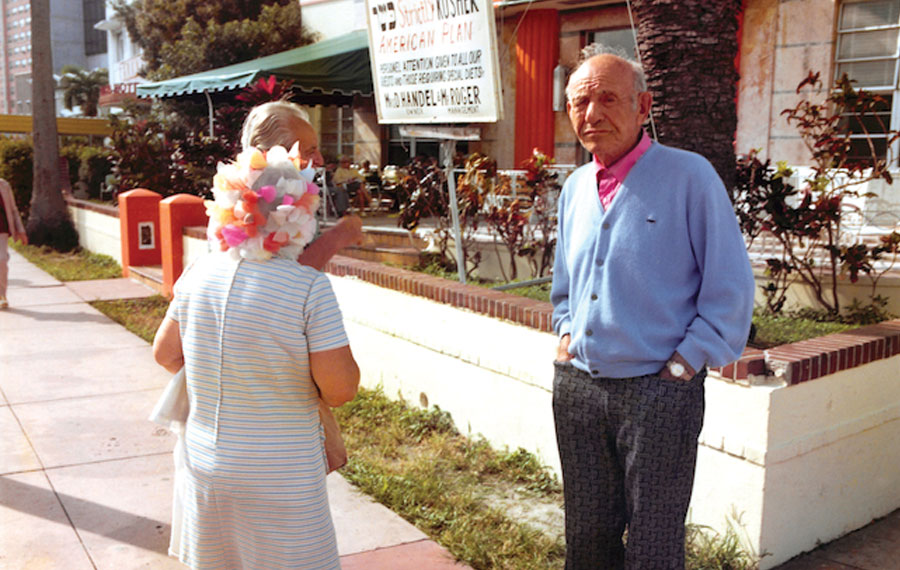 A photography by Andy Sweet
A photography by Andy Sweet Before it was made famous by the TV hit “Miami Vice,” and its boutique art deco hotels, clubs and chic cafés morphed it into a partygoer’s playground, the South Beach area of Miami Beach, Fla., was a very different place. In the three decades after World War II, South Beach was a largely Jewish community, a seaside mecca for older working-class Northeasterners seeking sunshine and an easier life.
The Jewish enclave is now gone but it lives on in the imagery of photographers Andy Sweet and Gary Monroe, creators of the Miami Beach Photographic Project. The documentary “The Last Resort” tells their story and serves as a tribute to a vibrant community and an important part of Jewish history.
Filmmakers Dennis Scholl and Kareem Tabsch, Miami residents who specialize in arts subjects, were familiar with the young Jewish photographers and their project and initially intended to make a short documentary about them. But they soon realized they needed to broaden their focus.
“The photographs are so beautiful and captivating. Anyone who sees them gets drawn in, as were we,” Tabsch told the Journal. “And the fact that these two young photographers chose to live and work among the elderly was such an interesting component. Like Gary and Andy, we fell in love with the people they were photographing. This rich, vibrant community had a story and a history that deserved to be told, preserved and celebrated.”
Neither filmmaker is Jewish, but Tabsch, of Lebanese-Cuban heritage, has some Jewish family on his Cuban side, and Scholl, whose wife is Jewish, considers himself “Jewish by osmosis.” They’re well versed in the history of Miami Beach, and South Beach’s Jewish history in particular.
“South Beach is known for its nightlife and discotheques, and the average age is 27. Just a few decades ago, the average age was 81 and the discotheques were Yiddish theaters.” — Kareem Tabsch
“Now South Beach is known for its nightlife and discotheques, and the average age is 27,” Tabsch said. “Just a few decades ago, the average age was 81 and the discotheques were Yiddish theaters. People have the image of little old ladies sitting on a porch and that was a part of it, but there was a thriving theater scene, too. There was music in the park every day, cinemas that would show Russian films, and touring acts that would play here. It was a large, culturally rich community with 10 to 15 synagogues.”
The film points out that many of the Jews were Holocaust survivors. Sunny Florida was a safe haven for them. “At one point there were 16,000 Holocaust survivors living in South Beach,” Scholl said. “It was a very specific subculture.”
“These were blue-collar folk who came down here and found their own slice of paradise by living in a community with others who shared a camaraderie and a common language — Yiddish — and for Holocaust survivors, a common experience,” Tabsch said. “They offered each other support and companionship during this era and had a wonderful quality of life for many years.”
Sweet’s and Monroe’s images reflect that good life, and they’re incorporated in the documentary along with footage from the Florida Moving Image Archives and other sources, along with interviews with Monroe, writer Edna Buchanan and South Beach residents and former residents.
Tabsch and Scholl are currently working on a documentary about Miami-based photographer Bunny Yeager, a model who became a pinup photographer in the 1950s and ’60s. Scholl recently completed work on “Singular,” about jazz vocalist Cecile McLorin Salvant, and “Lifeline,” a portrait of abstract expressionist artist Clyfford Still.
The theatrical release of “The Last Resort” is their current priority, however. “It’s particularly exciting for us to be showing in Los Angeles,” Tabsch said. “L.A. is one of the largest and most important Jewish communities in the country and many of the subjects of our film had family who made the move to the City of Angels, so this is like another homecoming. While our film is about a specific place and time, I think there’s a universal story in it that will appeal to Angelenos in particular,” he added, citing the “changing demographics, ever-evolving cities and the shared history” common to L.A. and Miami.
After its theatrical run, “The Last Resort” will be released on DVD with deleted scenes and bonus images in late March. It will premiere on Netflix in late spring.
“The Last Resort” opens March 1 at Laemmle Town Center 5 in Encino and Laemmle Music Hall.






















 More news and opinions than at a Shabbat dinner, right in your inbox.
More news and opinions than at a Shabbat dinner, right in your inbox.